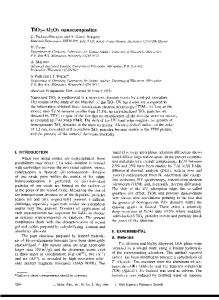Crystallization Behaviors of CaO-SiO 2 -Al 2 O 3 -Na 2 O-CaF 2 -(Li 2 O-B 2 O 3 ) Mold Fluxes
- PDF / 4,353,468 Bytes
- 13 Pages / 593.972 x 792 pts Page_size
- 78 Downloads / 341 Views
plays an important role in controlling the horizontal heat transfer and providing lubrication in continuous casting of steel which is the most important functions of mold flux.[1] The cast slab quality is closely related to the control of horizontal heat transfer between solidifying steel shell and mold. In continuous casting process, the horizontal heat transfer is controlled by both the thickness and the nature of the solid slag layer forming between solidifying steel shell and copper mold.[1] It is generally accepted that the heat transfer in continuous casting process is dependent on the crystallization behaviors of mold flux,[2–7] such as crystallization temperature and the types of crystalline phase. Therefore, it is required that the mold flux possesses proper crystallization properties to meet the requirement for heat transfer control in continuous casting. Many studies have been carried out to reveal the crystallization behaviors of lime-silica-based mold fluxes using various techniques, such as single or double hot thermocouple technique (SHTT/DHTT),[8–14] differential thermal analysis (DTA),[15–17] and confocal scanning
MYUNG-DUK SEO, Ph.D. Candidate, CHENG-BIN SHI, Postdoctoral Fellow, and SEON-HYO KIM, Professor, are with the Department of Materials Science and Engineering, Pohang University of Science and Technology (POSTECH), Pohang 790-784, Republic of Korea. JUNG-WOOK CHO, Research Associate Professor, is with the Graduate Institute of Ferrous Technology, Pohang University of Science and Technology (POSTECH), Pohang 790-784, Republic of Korea. Contact e-mail: [email protected] Manuscript submitted March 3, 2014. METALLURGICAL AND MATERIALS TRANSACTIONS B
laser microscopy (CSLM).[18–22] Liu et al.[9] studied the effect of Li2O on the crystallization of mold fluxes, and reported that the crystallization rate was promoted obviously in mold fluxes containing high Li2O content. Zhou et al.[10] observed that the increase of basicity tended to enhance the mold flux crystallization, and the isothermal crystallization activation energy decreased with increasing mold flux basicity. Lu et al.[12] reported that the increase of basicity would apparently promote the crystallization of lime-silica-based mold fluxes, while B2O3 had an opposite function. Hao et al.[15] reported that the growth and crystallization temperature of the cuspidine in lime-silica-based mold fluxes were suppressed by the absorption of titania. Wang et al.[17] studied the effect of TiO2 on the crystallization behavior of the slag, and found that TiO2 substitution for SiO2 in mold fluxes retarded the crystallization process. Ryu et al.[20] studied in situ crystallization of mold fluxes using a CSLM, and found that the crystallization temperature and crystallization tendency increased, whereas the incubation time decreased with increasing the basicity and alumina content of the mold fluxes. However, these previous studies are limited in thoroughly revealing the crystalline phase formation and crystal morphology characteristics in lime-silica-based mold
Data Loading...











